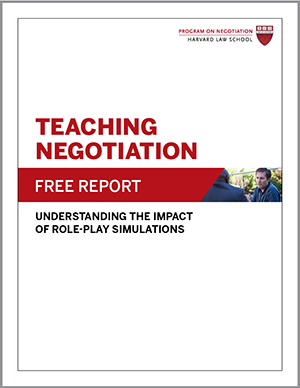
Little has been written on what it takes to create a great case study to use for teaching negotiation.
What needs to be taken into account in deciding whether a particular negotiation merits a written case study? What are the guidelines for writing negotiation cases? Do the traditional guidelines for preparing case studies in other fields apply?
Jim Sebenius, the Gordon Donaldson Professor of Business Administration at Harvard Business School, and Director of the Harvard Negotiation Project, addressed these questions in his presentation at the NP@PON Faculty Dinner Seminar on October 7, 2010. His article, “Developing Negotiation Case Studies,” began as a memo to a novice case writer about how to write an effective negotiation case. Now it is a full-length article that will appear in a forthcoming issue of Negotiation Journal.
Sebenius offers three kinds of advice to anyone thinking about writing a case as the basis for teaching negotiation to students or other interested audiences:
- How to decide whether a case lead is worth pursuing;
- How to select a perspective suited to your teaching objectives; and
- Ten nuts and bolts suggestions for structuring and producing an excellent case study.
Begin by asking, “Will this case contribute to better theory and yield prescriptive implications that can be generalized across diverse contexts?”
Sebenius also asks, “Will the case foster learning by allowing the reader to grapple with the experiences of others, and will it reveal the power and limits of received theory?” He urges case writers to clarify their goals and answer the question, a case for what? Knowing the purpose of the case will make it easier to decide the level of detail at which the writing should proceed.
Sebenius encourages case writers to rigorously investigate the worthiness of their protagonists in order to help answer the question, a case of what?
A compelling narrative will likely emerge if protagonists have attempted to overcome high barriers. This will increase the odds that the case reader will “relish the challenge” of wrestling with the same decisions that faced the protagonists. On the other hand, Sebenius is quick to caution against being taken in by the lure of a writing a case mainly on the basis of high profile protagonists or well-known settings when the negotiation itself may not be that interesting.
Ultimately, a good case prospect will permit the case writer to fill in two key blanks: “This appears to be an intriguing case of ___, and thus, worth delving into more deeply, in order to use for the following reason(s)___.”
Once it is clear what the case is for and what it is a case of, the case writer must choose a case type and perspective.
Protagonist vs. Situation:
Protagonist-centered cases require the reader to grapple with difficult decisions and often to understand the challenge from one or more specific perspectives, placing the reader in the shoes of the person(s) facing specific negotiation challenges. Situation-centered cases are written from a non-specific perspective, allowing the reader to understand all the details of what occurred.
Decision vs. Autopsy:
Decision cases are experiential, putting the reader in the shoes of the protagonist, requiring them to grapple with tough decisions. They are often written in “real time,” so students must make decisions without knowing the outcome. “Autopsy” cases give the reader all the information from beginning to end, inviting discussants to analyze what did happen and why; they normally lack the tension of decision cases.
Library vs. Field:
Library cases rely on secondary materials while field cases are based on interviews and access to non-public information. Though field cases are generally preferable, Sebenius acknowledges the challenge of getting protagonists to approve of what’s included in the case.
Actual or Disguised:
Actual cases use accurate names and facts while disguised cases preserve the essential negotiation issues while hiding these identifying characteristics. Though actual are preferable, some situations may be too sensitive to include real names.
John Hammond, an experienced Harvard case writer, points out that disguising cases can invite protagonists to be more forthcoming.
For teaching negotiation purposes, Sebenius has found protagonist-centered, actual, decision cases that are field-based are the most effective. They require students to face tough decisions based on imperfect information and uncertain circumstances-exactly as is the case in reality.
The last section of the report gives nuts and bolts advice on how to structure and produce cases. They should have multiple parts that advance the case, highlighting multiple decision points. Part A might present the reader with background information and indicate the specific challenges facing the protagonist. Part B could then explain what the protagonist did to address these challenges. Cases do not have to be limited by only two parts, of course, and they can be enhanced by video supplements of various kinds.
Sebenius urges case writers to begin by getting down the critical elements of the story. Structuring the material under various analytical headings is (initially) secondary to capturing the raw material for the ultimate case. The narrative should include enough information for readers to identify barriers to agreement. Case writers should pursue interviewees from all sides of the negotiation or dispute and seek feedback from outside readers to help identify gaps and biases. Although it is challenging, Sebenius urges cases writers to limit themselves 4-6 pages (ideally) to ten printed pages (maximum) for each part (“A”, “B”, etc.). He points out that there are even 2-4 page cases that contain all the classic tensions needed to support rich discussions yielding powerful lessons. He suggests that case authors present sufficient raw material to enable readers and discussants to draw their own conclusions, and save any editorializing and analysis for an accompanying teaching note.
Reactions to Sebenius’ Negotiation Pedagogy at the Program on Negotiation (NP@PON) Presentation
One participant asked to what degree Sebenius’ criteria for writing negotiation cases might apply to preparing other kinds of teaching cases as well.
Does teaching negotiation present specific challenges or opportunities with regard to the cases we develop or how we teach them?
Sebenius acknowledged that there are a lot of articles on how to write great case studies. Harvard Business School, which played a key role in developing the case method of instruction, has produced many works on this topic. For the purposes of teaching negotiation cases, though, one must be sure that certain key elements are covered including multiple perspectives, the interests of the parties, their BATNAs, what was and wasn’t communicated, the role of “second tables,” etc.
In terms of case type and perspective, John Hammond (Harvard Business School) suggested that many cases are hybrids and cautioned against such either/or choices. For example, if you disguise a case, people may be more likely to be open about what really happened. Sometimes it is possible later on to turn a disguised case into an attributed case. Lisle Baker (Suffolk University Law School) challenged Sebenius’ assertion that open cases are always preferable in a classroom setting.
Baker suggested that there might be value in a disguised case rather than an open case when dealing with a generalist audience with a particular bias.
Mike Wheeler (Harvard Business School) asked, “Does a case have to be real to be an effective teaching piece?” A number of participants highlighted situations in which fictional cases were effective teaching tools. Several participants even suggested potential ways to evaluate the effectiveness of fictional versus true cases.
Dan Shapiro (Harvard Medical School) suggested comparing the effectiveness of two classes that emphasize the same core concepts, one using traditional cases and the other using the Iliad or Shakespeare.
Susan Podziba (a Boston area mediation practitioner) said that fiction often “gives us something that resonates with our humanness and with our experience outside an analytic negotiation.” The audience agreed that there are many lessons that can be drawn from a close analysis of fiction writing, including how to keep a reader engaged and the undeniable power of a compelling narrative.
Wheeler commented further on case writing experiences he has had in which a case develops meaning that he could not have anticipated from the start. There was agreement that case writing is usually an iterative process and that a case continues to reveal itself and develop as it is being written and taught. Susan Podziba asked, “How do you capture this understanding for new case writers and help them remain open to surprises as they are writing a case?”
In light of the Sebenius challenge regarding keeping cases succinct, Mike Wheeler asked whether it might be useful to present cases in graphic form.
Gordon Kaufman (MIT’s Sloan School of Management) suggested we should take a successful case and present it in classic and graphic form and teach it to multiple classes, so that we could have a basis for judging the incremental effectiveness of one modality over another.
Panelists elaborated on ways of evaluating the effectiveness of cases and case instruction in the teaching negotiation field. Larry Susskind (MIT’s Department of Urban Studies and Planning) asked if there is an empirical basis for Harvard Business School’s commitment to the case teaching method. He suggested asking alumni to identify specific cases that enhanced their ability to handle a negotiation in practice. Mike Wheeler pointed out that because cases are part of a larger curriculum, it might not be possible to figure out the impact of particular cases on a student’s subsequent negotiating capabilities.
Florrie Darwin (Harvard Law School) emphasized that there is a difference between what people learn and what people remember. Sebenius summarized the ongoing challenge in the field “to explore more systematically the various aspects of cases and how they map onto student learning.”
Written by Carrie O’Neil, edited by Warren Dent, taken from the bi-annual e-newsletter Negotiation Pedagogy at the Program on Negotiation E-Newsletter (NP@PON), which can be found here.
Related Article: New Program on Negotiation Teaching Materials About Great Negotiator Martti Ahtisaari
Originally published in 2010.




